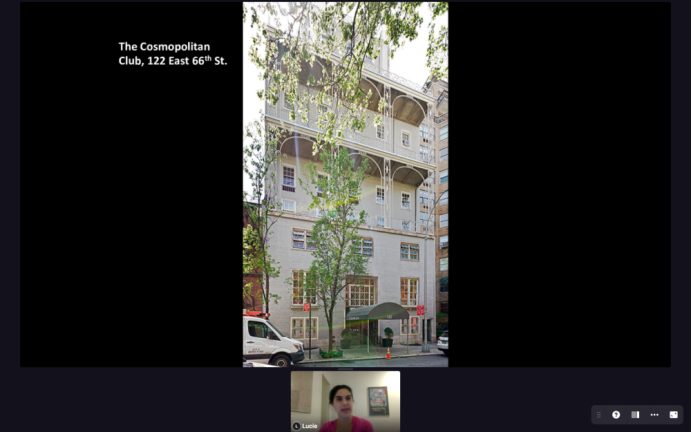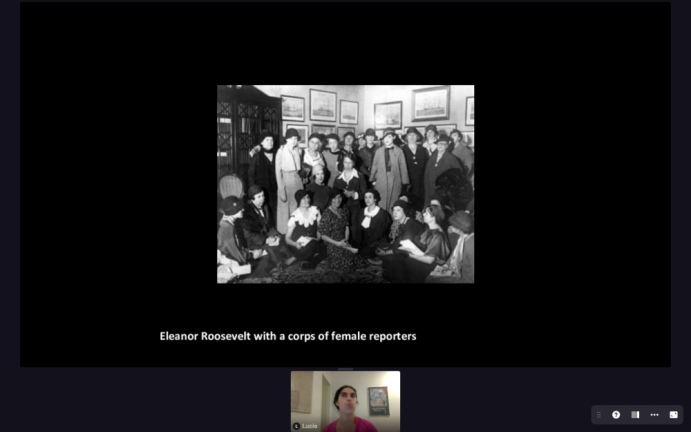Making Space, Viewing the Spaces
New York Adventure Club discusses the historic women’s institutions of the UES
On the Upper East Side, it’s hard to find a building that doesn’t look like it’s a piece of history. The New York Adventure Club, in its virtual walking tour of historic women’s institutions of the Upper East Side, showed that history lives in plain sight, even if we aren’t aware of it.
Led by writer and historian Lucie Levine, the webinar on June 24 began with The Colony Club at 564 Park Ave, and proceeded north through the neighborhood, passing through spaces like the Cosmopolitan Club, the Barbizon Hotel, Hunter College and the First Hungarian Baptist Church. “These are spaces in which women could create space for themselves, nurture ideas that they had, professions they pursued, and in certain circumstances, create new lives for themselves.” Levine explained.
Threading through the legacies of clubs, universities, and hotels for women in the Upper East Side were the social and political values of the times they were founded. At its founding, the Colony Club was called the “death nail” of the home. The question of morality, impropriety, and an emphasis on good breeding was never far behind in the creation of these spaces, meaning that access to them was for the elite, and for the “correct kind.” More often than not, this meant discrimination against women who weren’t white and wealthy.
The famous Barbizon hotel at 140 East 63rd Street, known as the one-time home of Joan Didion, Grace Kelly and Sylvia Plath, maintained a very traditional view of womanhood, while being a place of formative change for many women to access education and job opportunities. Tenants of the Barbizon brought three references, and were assessed on “Looks, dress, and demeanor.” While the Barbizon allowed young women access and freedom in many ways, the focus on social status, and the look and feel of a the hotel as a place for the elite, meant that the “Barbizon girls” still needed to embody the traditional female values of the time.
Women as Leaders and Founders
Also discussed were the forces behind the creation of these places, the women themselves, and their unusual lives. Elsie de Wolfe, the interior decorator of the Colony Club, was “one half of the most illustrious lesbian couples in the city,” Levine said. Florence Harriman, the founder of the Colony Club, led suffragettes down Fifth Avenue. Eleanor Roosevelt as First Lady, and as a member of women’s clubs, went on to hold all-female press conferences, “putting women at the forefront of asking questions about foreign policy, and at the forefront of their profession,” Levine explained. “They aren’t crowded out of the field, they’re crowding around the most important place to be.”
Perhaps the most interesting moment of the discussion was of the life story of Victoria Earle Matthews, a formerly enslaved woman who went on to become a journalist and lecturer, who founded the The White Rose Mission, or the White Rose Industrial Home for Working Class Negro Girls, originally located at 217 East 86th Street. The home provided employment services to young women, and was home to “one of the largest and best respected collections of African American history and culture in the entire city.” In the face of racism and sexism, meeting places and places of culture for women were created and cultivated in the Upper East Side.
Too often we can walk by a place and not understand or know its history, or how it shaped New York, and the world that exists today. “These spaces that women created in New York City, allowed them to launch public lives that would not have been possible without these spaces.” Levine explained, “It’s a question of how are women building community, how are women building a space for themselves...how are women creating the opportunity of the future? We see that again and again.”
Other Webinars can be found at the New York Adventure Club: https://www.nyadventureclub.com/
“These are spaces in which women could create space for themselves, nurture ideas that they had, professions they pursued, and in certain circumstances, create new lives for themselves.” Writer and historian Lucie Levine

